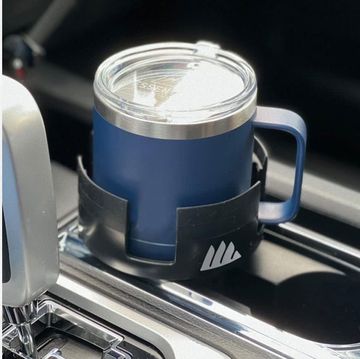Before easing out of the fast-food's parking lot, you grab a sip of the hot coffee you picked up at the drive-thru. You take your time as you place the cup in its holder in the center console. No hurry. The approaching traffic may be moving fast, but it's far enough away for you to accelerate up to cruising speed. Good thing, because at about half-throttle you feel the engine misfire. The closing traffic has time to back off and let you sputter up to road speed. But now your engine sputters like a Harley idling at the curb, even at normal traffic speeds. And there's coffee all over the console from the vibration.
What's Up?
A brief underhood inspection confirms that all the vacuum hoses are on and that none of them have been burned open by leaning against the exhaust manifold. You've touched every sensor connection to see if it's on tight, you've even checked for trouble codes.
However, not everything calls for high-tech diagnostics and the latest scan tester. Engine misfire often is caused by leaking spark plug wires, so visual inspection could reveal what's wrong. The jackets may be damaged from the outside by abrasion caused by engine vibration (particularly at the plug-end boots), a hot engine compartment, spilled fluids or battery acid, multiple disconnections and reconnections for other service, or even a family of nesting rodents.
Run the engine in near darkness, and then look and listen. If you see little electrical arcs, or hear a snap-crack, there is high-voltage electrical leakage. Of course, running the engine at idle doesn't exercise the ignition system very hard, so you can add something to the test by spraying the plug wire ends with clean water from a household spray bottle.
Another test: With a jumper wire, ground the metal shank of a screwdriver that has a well-insulated handle. Then, run the tip of the screwdriver along the length of each wire and all around at the coil and plug boots. This will often produce an arc from the wire to the screwdriver.
Now look at the wires under good lighting. If they are damaged by abrasion, oil-soaked, cut, burned from contact with the exhaust, or have a dried-out look with heat cracks, it definitely shouldn't be a surprise if you see arcs in the dark under some conditions. However, if they look bad but there are no arcs, do a resistance check.
A conventional plug wire has a resistance of 10,000 to 15,000 ohms per foot of length--if it's measurably higher, the wire probably is bad. An absolutely failed wire will have a hairline break somewhere, and the resistance will be infinity.
Replace plug wires one at a time to maintain the exact same routing as original. Use silicone grease on the boots to allow easy removal in the future.
Inexpensive boot pliers allow you to remove stuck plug wires without damage.
Out With The Old, In With The Newd
Once you've found a bad wire, the solution should be simple: Replace the plug wires.
First, you have to decide whether you want to buy from a car dealer at list price or get a quality aftermarket brand, if you have that choice. Prices for 1980s models may be under $35 for a popular make at the parts store. For a late-model V8, be prepared to pay the dealer up to $200 or more, even for a popular car.
A word of caution: You may not want "high-performance" wires, even if they fit your car (and they may be cheaper than a conventional type). Some high-performance wires are not the resistance type, and although they may do well on racing cars, they can affect the operation of underhood electronics by not containing radio waves.
The actual method of removing the old wire is not always "just pull it off." Pulling on the wire itself is sure to cause an internal separation. Of course, if you're replacing a bad wire, it may not matter, but if any one of the old wires is still good, it's best to keep it as a spare.Grasp the plug wire by the boot at the plug end. If it's in a recess or is difficult to access for some other reason, use a spark plug wire tool. There are special pliers of all sorts designed to reach in and grasp the boot. They're not expensive, and having them could prove useful if you ever have to disconnect wires for other underhood service. Twist the boot if necessary to break the heat seal to the plug, then pull. As you do this take note if you feel some looseness at the connection (it may have been caused by engine vibration).
The plug wire usually is more accessible at the coil end, but it may not be a simple push-on. Since the early 1980s, Chrysler plug wires on engines with distributors have been held in the cap by spring clips. Compress the tangs of the clip with pliers and push out to disengage the wire. Some Japanese makes have thread-in "boots."
Follow the routing of a spark plug wire as if it were the road to success, because when it comes to engine operation, it really is. Every manufacturer includes little plastic guides, and although they may cost pennies to make and install, they're used to locate each wire so it doesn't cause crossfire (a transfer of high-voltage electricity from one cylinder's wire to the one that's next in the firing order). If you see one wire crossing over or under another at nearly right angles, that's an example of the routing strategy used to avoid crossfire. Of course, on some engines with coil-on-plug ignition (COP), there is no wire and the boot is out of sight, out of mind. Although this type is immune to hungry rodents, a boot may suffer internal damage from high-voltage electricity or cracking from engine heat. It's even possible for spilled oil to flow under the cover and get down onto the boots on some cars, so have a rag handy when you're adding engine oil. It's impractical to check these boots with the engine running, so you've got to remove the ignition cover and lift the COP modules to make a physical inspection. There are some "hybrid" designs, with one coil on one plug to serve two cylinders. The coil directly feeds a plug in a boot underneath, and there's a plug wire (replaceable) to a second plug.
The COP boots alone are usually under $25 a set, and are strictly a dealer part. Just pull the coil/electronics module off the plug and then pull the boot off the module. If the boot is integral with the electronics the price could be $100 each.
There's no maintenance you can perform to extend the life of plug wires. However, before you install the boot on the plug, coat the inside with boot release lube (a silicone grease) to make it easier to remove next time. And whenever you work under the hood, avoid nicking the wires, spilling solvent on them, or mishandling if you have to set them aside while you work on something else. And if you see a wire dangling very close to the exhaust manifold, reposition it in its guide to gain some clearance. A penny of prevention can be worth a couple of hundred dollars of cure.
Some wires are secured inside the cap by spring clips. Use needle-nose pliers here.
Many newer cars have individual coils mounted on the plugs. Short wires connect opposite-firing cylinders.
Dampen the wires with a spray bottle and clear water, and look for arcs with a grounded, insulated screwdriver.
HOW IT WORKS: Spark Plug Wires
The spark plug wire has a seemingly simple job: Carry the high-voltage electricity produced by the ignition coil to the terminal of the spark plug. Once at the plug, the electricity travels to the other end of the plug, and jumps a gap between electrodes to produce the "spark" that ignites the fuel mixture. Because high-voltage electricity looks for an easier path to jump across than a pair of electrodes in a spark plug, containing the electricity within the wire takes a thick jacket of insulation, and some plugs have an outer jacket to resist cuts, high underhood temperatures, etc. If that outer jacket is damaged, the electricity may leak out to follow the easier path. In addition, high-voltage electricity produces radio waves, which can cause interference with all types of on-car electronic devices, from sensors and computers to radios and other entertainment systems. So, a simple length of solid wire can create problems.
The electrical conductor typically has a carbon-impregnated core of a suitable fiber, and everything from nylon to Kevlar has been used by different makers. That conductor (often covered by a second layer of a nonconductive material such as synthetic rubber) has enough electrical resistance to suppress radio interference without unduly weakening the spark. Some premium wires may have copper or stainless steel wire wound around the carbon core to reduce resistance. In some special applications in which minimum resistance is needed for engine performance, a solid metal wire has been used as a conductor, but over the inner layer of insulation is a layer of wound wire as a shield. On other types of wires, the outer jacket of the wire may have a metallic shield to prevent interference.














